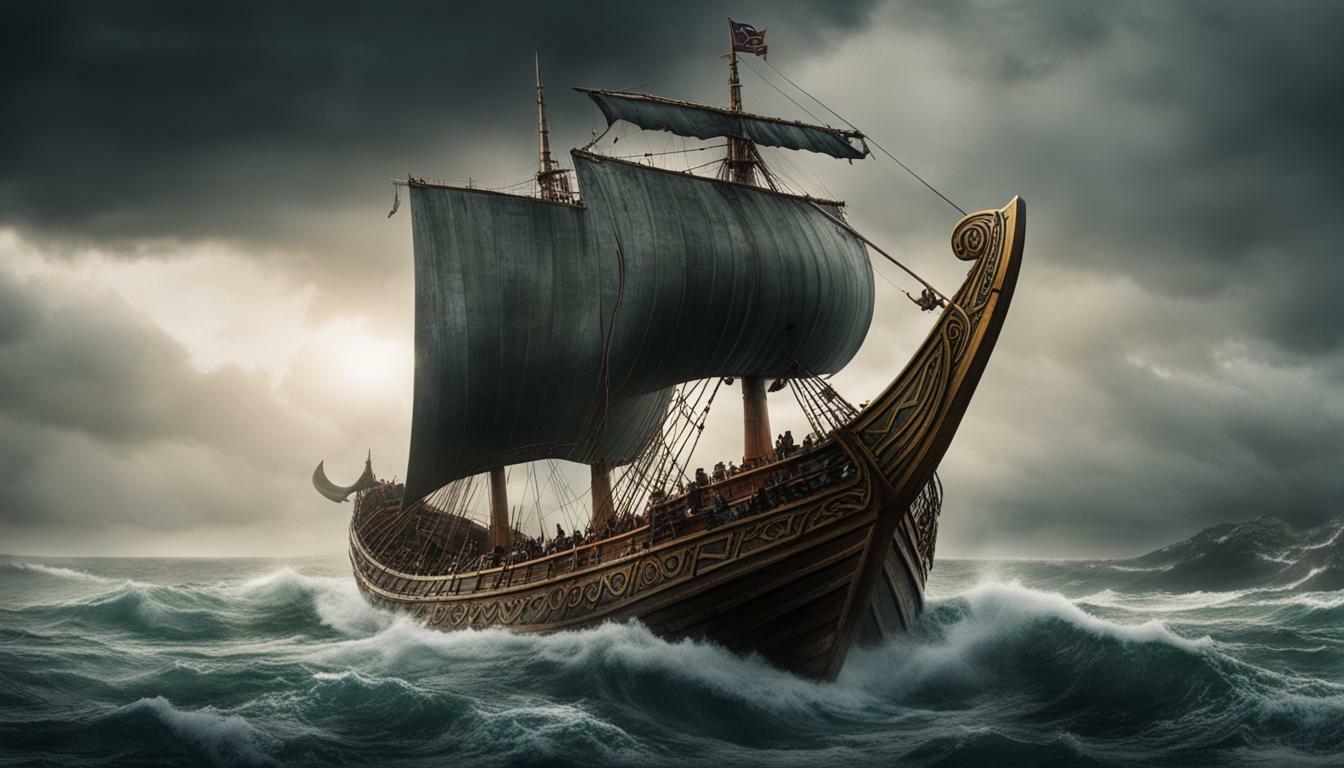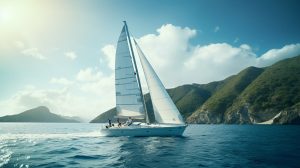The Vikings, Scandinavian seafarers who were active from the 8th to the 11th century, played a significant role in history, especially in terms of their ships. Viking ships were crucial for their expansion, as they were used for transportation, trade, and warfare. Norway, being the home of the Vikings, saw the development of these incredible vessels that could navigate various bodies of water, from lakes and rivers to fjords and the open sea.
The earliest Viking ships, such as the Oseberg, Gokstad, and Tune, were versatile and used for various purposes, including transport and battle. However, by the end of the 9th century, specialization began to emerge, particularly in the creation of warships. These warships were longer and slimmer, enabling them to navigate sheltered waters, where Vikings could discreetly enter their target locations. Once their objective was achieved, the warships provided a quick getaway for the Vikings and their loot.
Key Takeaways:
- Viking ships were crucial for the Vikings’ expansion, used for transportation, trade, and warfare.
- The earliest Viking ships were versatile, but specialization began to emerge in the creation of warships by the end of the 9th century.
- Warships were longer and slimmer, enabling the Vikings to navigate sheltered waters and make a quick getaway.
Evolution of Viking Ships: From Versatility to Specialization
The earliest Viking ships, such as the Oseberg, Gokstad, and Tune, were versatile and used for various purposes, including transport and battle. These ships were smaller and more flexible, with a broader beam than later models. The ships could hold between 20 to 30 men, depending on the size, and were equipped with both sails and oars.
However, by the end of the 9th century, specialization began to emerge, particularly in the creation of warships. These warships were longer and slimmer, enabling them to navigate sheltered waters, where Vikings could enter their target locations discreetly. Once their objective was achieved, the warships provided a quick getaway for the Vikings and their loot.
In the 10th century, specialization became more pronounced. Warships were further categorized into different types of longships. Skeiðar referred to longer and narrower vessels, while drakkar had dragon or serpent heads. Additionally, smaller longships were known as snekke.
Cargo ships, on the other hand, had a larger carrying capacity and relied solely on sails for movement. These ships could be manned by a small team and were distinct from longships, which utilized both sails and oars to achieve high speeds for surprise attacks.
The evolution of Viking ships, from versatile vessels to specialized warships, is a testament to the Vikings’ ingenuity and craftsmanship. These ships allowed the Vikings to expand their reach beyond Scandinavia, exerting their influence across Europe and beyond.
Categorization of Viking Warships and Cargo Ships
In the 10th century, specialization became more pronounced. Viking warships were categorized into different types of longships. Skeiðar referred to longer and narrower vessels, while drakkar had dragon or serpent heads. Additionally, smaller longships were known as snekke. These specialized warships were designed for swift attacks and could navigate shallow waters, making them ideal for ambushes.
Cargo ships, on the other hand, were designed for transportation and trade. These ships were larger and had a larger carrying capacity than warships. They relied on sails for movement and were manned by a small team. Cargo ships were distinct from longships, which utilized both sails and oars, making them faster and more agile for surprise attacks.
Ancient Viking ship names often reflected the ship’s purpose, such as dreki (dragon), or the geographical location it operated in, such as langskip (longship). The Vikings also had unique names for their ships that reflected their individuality and personality.
One example is the Ormen Lange, meaning ‘long serpent’ in Old Norse, which was one of the largest warships of its time. The Ormen Lange was said to be so long that the front and back could not be seen from one end. Another example is the Skidbladner, which was the ship of the Norse god Freyr. It had the ability to shrink in size and fit inside a pocket, making it a unique and mythical vessel.
Navigation Techniques of the Vikings
One fascinating aspect of Viking navigation was the absence of compasses, sea charts, or logs. Instead, Vikings relied on their knowledge of the sun, stars, wave patterns, wind direction, and cloud formations to navigate. Sundials were crucial for determining the position of the North Pole, but recent research proposes the use of sunstones, crystals that shine brightest when pointed towards the sun, even on cloudy days. The behavior of birds and sea mammals also helped guide the Vikings on their journeys.
The Impact of Viking Ships on Scandinavian and European History
The Vikings exhibited remarkable seafaring skills, and their ships allowed them to explore and trade across Europe. These ships were instrumental in their expansion and played a crucial role in their trades and conquests. Viking ships were not just vessels of transportation, but also tools of warfare. They were used to launch surprise attacks on unsuspecting targets and allowed the Vikings to travel across the open seas, including the Atlantic Ocean.
The Vikings had a significant impact on Scandinavian and European history. Their ability to raid and trade across the continent had far-reaching consequences that shaped the development of Europe. The Vikings created a trade network that spanned from Russia to North America and left their influence on many cultures they interacted with. Their ships allowed them to explore and settle new lands, which contributed to the development of new societies.
Many famous Viking ship names are celebrated in history, including the Oseberg, Gokstad, and Tune. These ships have been studied and preserved, providing valuable insights into the Viking Age. Their unique names evoke the spirit of the Viking seafarers and their mastery of shipbuilding and navigation.
Legendary Viking ship names, such as the Skidbladner and Naglfar, were mentioned in Norse mythology and were believed to possess otherworldly powers. These ships were said to have the ability to transform size or speed instantly and were considered to be prophecies of events to come.
Popular Viking ship names were given to ships that were frequently used for travel and trade, such as the Knarr. These ships were used for transportation of goods and were instrumental in the development of trade routes. Viking ships also influenced the development of naval fleets in Europe, with many countries adopting their shipbuilding techniques and designs.
The Viking Age was a time of exploration and conquest, and their remarkable ships played a crucial role in shaping the history of Europe. Today, many of these ships are celebrated and revered, with museums dedicated to their preservation and study. The Gokstad ship, one of the most significant Viking ship finds, remains a testament to the ingenuity and skill of Viking shipbuilders and is a must-see for anyone interested in Viking history.
The Gokstad Ship: Unearthing Viking History
The Gokstad ship, discovered and excavated from the shores of the Oslofjord in 1880, remains one of the most significant finds from the Viking Age. This 9th-century Viking-era vessel was suitable for open-ocean voyages, combining flexibility and speed. It could be sailed or rowed, making it ideal for raiding and trading abroad. The Gokstad ship had 16 oar holes on each side and could accommodate a crew of 34 people, with limited storage space below deck.
Named after the burial mound near Sandefjord, Norway where it was found, the Gokstad ship is currently displayed at the Oslo Viking Ship Museum. Its exceptional state of preservation continues to fascinate visitors. The ship’s condition, despite being underground for nearly 1,000 years, is remarkable, with much of the original wood still intact.
Upon its discovery, the Gokstad ship attracted attention due to its association with a burial mound previously labeled Gokstadhaugen/Kongshaugen, meaning “King’s Mound” in Old Norse. While initially dismissed as folklore, later excavations revealed numerous items in the grave, suggesting the burial of a powerful figure, possibly a local chieftain. No weapons, gold, or silver were found, leading experts to believe that such valuable items were likely plundered long ago.
The Gokstad Ship: Unearthing Viking History
| Type of Viking ship | Description |
|---|---|
| Norse Viking ship | The Gokstad ship was a Viking longship built by Norse Vikings for oceanic voyages. It was 23.3 meters long and 5.2 meters wide. |
| Traditional Viking ship | The Gokstad ship was designed with a keel and sturdy planking, typical of Viking ships of its era. |
The Gokstad ship underwent restoration to preserve its condition after being displayed for years without intervention. Restoration efforts included dismantling, steaming, and bending back the timber to its original shape. Some sections required replacement with new timber. The complete restoration was carried out approximately fifty years after the ship’s discovery, securing its place as the largest preserved Viking ship in Norway.
Today, visitors to the Oslo Viking Ship Museum have the opportunity to witness the magnificence of the Gokstad ship, a testament to Viking shipbuilding prowess. The museum, located in Bygdøy peninsula, offers a glimpse into Viking history and the significance of their ships.
The Enigmatic Burial Mound and Its Possible Owner
Upon its discovery, the Gokstad ship attracted attention due to its association with a burial mound previously labeled Gokstadhaugen/Kongshaugen, meaning “King’s Mound” in Old Norse. The mound is located on the southern side of the Gokstad farm, where the ship was found.
The mound, measuring 75 meters in circumference and 5 meters in height, had been abandoned and suffered significant damage by the time the Gokstad ship was discovered. Excavations revealed that the mound had been significantly altered, and there is evidence of previous excavations carried out in the 17th century. The reasons behind the changes and the original purpose of the mound remain unknown.
“It is hard to say who was buried in the Gokstad ship, but he must have been a man of wealth and importance,” said Gabriel Gustafson, a curator at the University of Oslo in 1880.
Further excavations carried out in the 20th century revealed the presence of grave goods, including a wooden cart, a four-wheeled wagon, and several animal skeletons. These items suggest that the individual buried in the Gokstad mound was likely a highly respected member of Viking society with significant wealth and status.
Despite the lack of evidence of any valuable items in the burial chamber, the Gokstad ship remains an essential artifact in understanding Viking shipbuilding and seafaring. The significance of the burial mound and its occupant continues to elude researchers and historians, leaving much to be discovered about the Viking Age and its people.
Restoration and Preservation of the Gokstad Ship
The Gokstad ship underwent restoration to preserve its condition after being displayed for years without intervention. Its exposure to the elements and handling by visitors took a toll on the vessel, and there were concerns about its long-term preservation. The restoration work on the ship began in 1913 and lasted three years. The work was carried out by a team of experts who were tasked with returning the ship to its original state.
The restoration process was a meticulous one that required a significant amount of effort and skill. The ship was dismantled, and each plank was numbered to ensure that it was put back in the correct place. The experts then steamed each plank to make it pliable and bent it back into its original shape. Some sections of the ship had to be replaced with new timber, but the majority of the wood was original. Once the restoration work was complete, the ship was reassembled and put on display at the Oslo Viking Ship Museum.
Today, visitors to the museum can see the magnificent Gokstad ship in all its glory. The ship’s state of preservation is exceptional, with much of the original wood still intact. Visitors can see the intricate details on the ship’s interior, including the carvings on the steering oar and the animal heads on the bow and stern. The Gokstad ship is the largest preserved Viking ship in Norway and is a testament to the skill and ingenuity of Viking shipbuilders.
Preserving Viking history for future generations
The restoration of the Gokstad ship was not just about preserving a historical artifact for visitors to see. It was about preserving Viking history for future generations. The Gokstad ship is a valuable resource for researchers and scholars who want to study Viking shipbuilding techniques and the seafaring practices of the Vikings. By restoring the ship to its original condition, experts ensured that it would be available for study and research for many years to come.
The restoration process also highlighted the importance of ongoing preservation efforts. The Gokstad ship is just one of many historical artifacts that require constant attention to ensure that they remain intact. As more Viking ships and artifacts are discovered, it is essential to have preservation measures in place to ensure their survival. These measures must include ongoing restoration and maintenance work, so that future generations can learn about the fascinating history of the Vikings and their remarkable seafaring legacy.
The Oslo Viking Ship Museum: A Window into Viking History
Today, visitors to the Oslo Viking Ship Museum have the opportunity to witness the magnificence of the Gokstad ship, a Viking-era vessel that remains one of the most significant finds from the period. Located in Bygdøy peninsula, the museum houses a variety of artifacts, including the Gokstad ship, offering a glimpse into the seafaring legacy of the Vikings and their remarkable ships.
The museum’s exhibits provide a unique perspective on the significance of Viking ships and their contributions to Scandinavian and European history. Visitors can admire the intricate craftsmanship of Viking vessels, such as the Oseberg ship, which dates back to the 8th century and is renowned for its exquisite carvings and decorations.
The museum also showcases the evolution of Viking ships, from versatile vessels used for transport and battle to specialized warships and cargo ships. The categorization of Viking ship types, such as skeiðar and drakkar, provides a fascinating insight into the Viking’s naval tactics and warfare strategies.
The Gokstad ship, however, remains the museum’s most significant attraction. The ship’s exceptional state of preservation and unique design continue to fascinate visitors, while its association with the burial mound near Sandefjord offers a glimpse into Viking burial customs and the social hierarchy of the time.
By taking a tour of the museum, visitors gain a deeper understanding of Viking culture and the importance of their ships. The museum’s expert guides and interactive exhibits provide an engaging and educational experience for all ages, making it a must-visit destination for history enthusiasts and anyone interested in Viking ships and their impact on our past.
If you’re interested in exploring Viking history and the significance of their ships, a visit to the Oslo Viking Ship Museum is highly recommended. With its vast collection of artifacts and exhibits, the museum offers a unique window into the seafaring legacy of the Vikings, including the magnificence of the Gokstad ship, one of the largest preserved Viking ships in Norway and a true testament to Viking shipbuilding prowess.
Conclusion
The Vikings’ seafaring legacy and their remarkable ships continue to intrigue and fascinate. Their ships were vital for transportation, trade, and warfare, with specialization beginning to emerge in the creation of warships by the end of the 9th century. Viking navigation techniques were based on their knowledge of natural elements such as the sun, stars, wave patterns, wind direction, and cloud formations. Their impact on Scandinavian and European history is significant, and a visit to the Viking Museum in Oslo is highly recommended to discover more about Viking ships.
The Gokstad ship stands out as one of the most significant finds from the Viking Age, with its exceptional state of preservation and fascinating history. The ship’s restoration efforts have secured its place as the largest preserved Viking ship in Norway, and visitors to the Oslo Viking Ship Museum can witness the magnificence of this Viking-era vessel.
In conclusion, the exploration of Viking ship names and their contributions to our past reveals the remarkable ingenuity and skill of these Scandinavian seafarers. Continued research and archaeological excavations offer significant opportunities to unravel the mysteries of our past, and the story of Viking ships is an integral part of this ongoing journey.
FAQ
Q: What were Viking ships primarily used for?
A: Viking ships were used for transportation, trade, and warfare.
Q: How did Vikings navigate without compasses or sea charts?
A: Vikings relied on their knowledge of the sun, stars, wave patterns, wind direction, cloud formations, as well as the behavior of birds and sea mammals to navigate.
Q: Where can I see the Gokstad ship?
A: The Gokstad ship is currently displayed at the Oslo Viking Ship Museum in Oslo, Norway.
Q: How many oar holes did the Gokstad ship have?
A: The Gokstad ship had 16 oar holes on each side.
Q: What types of longships were there?
A: Skeiðar referred to longer and narrower warships, drakkar had dragon or serpent heads, and smaller longships were known as snekke.
Q: Are there any valuable items found in the Gokstad ship?
A: No weapons, gold, or silver were found in the ship, leading experts to believe they were likely plundered long ago.
Q: What makes the Gokstad ship significant?
A: The Gokstad ship is one of the most significant finds from the Viking Age and remains the largest preserved Viking ship in Norway.
Q: Where can I learn more about Viking ships?
A: To learn more about Viking ships, a visit to the Viking Museum in Oslo is highly recommended.
Q: What was the capacity of the Gokstad ship?
A: The Gokstad ship could accommodate a crew of 34 people with limited storage space below deck.
Q: How was the Gokstad ship restored?
A: The Gokstad ship underwent restoration, which included dismantling, steaming, and bending back the timber to its original shape, with some sections requiring replacement.



